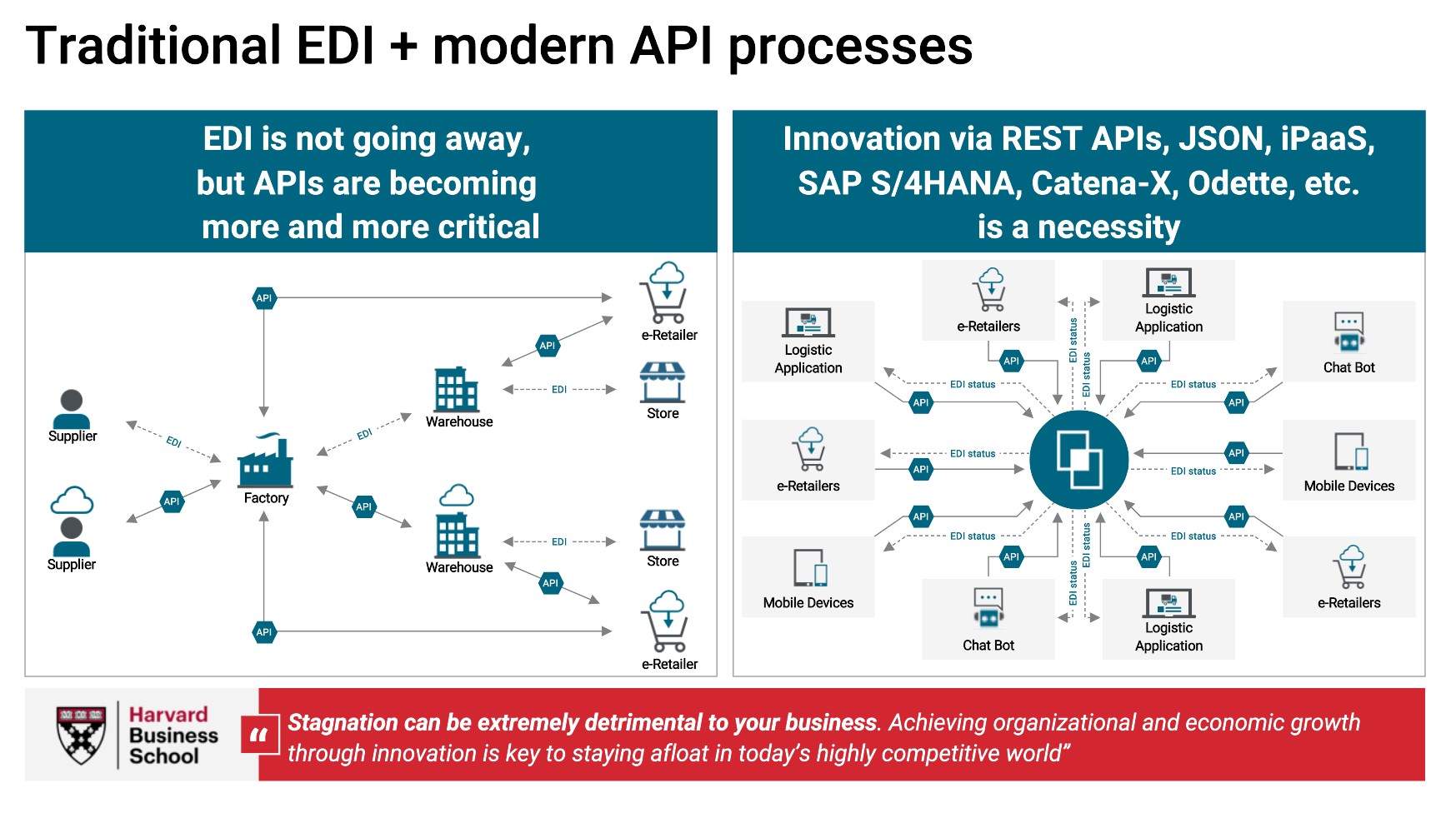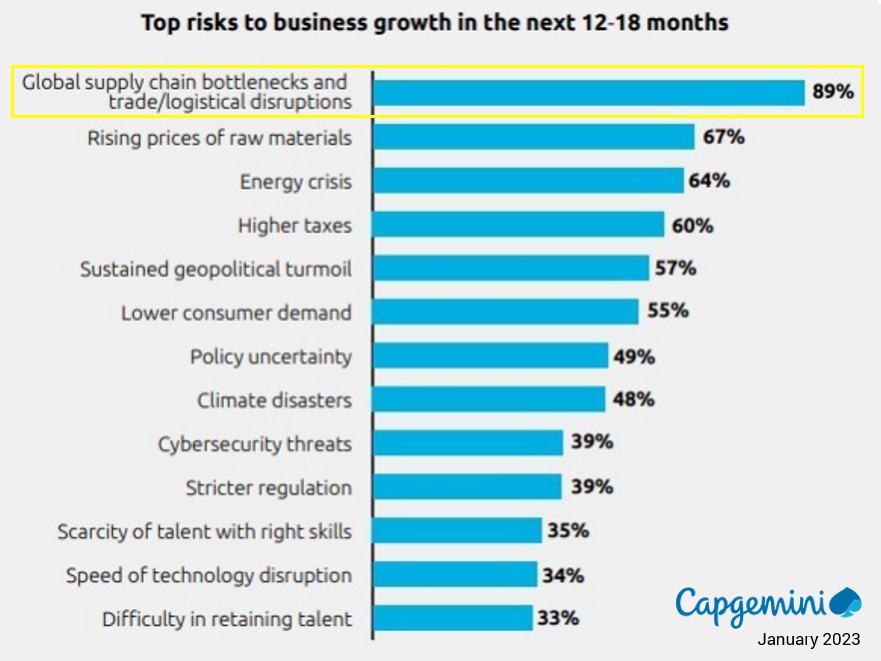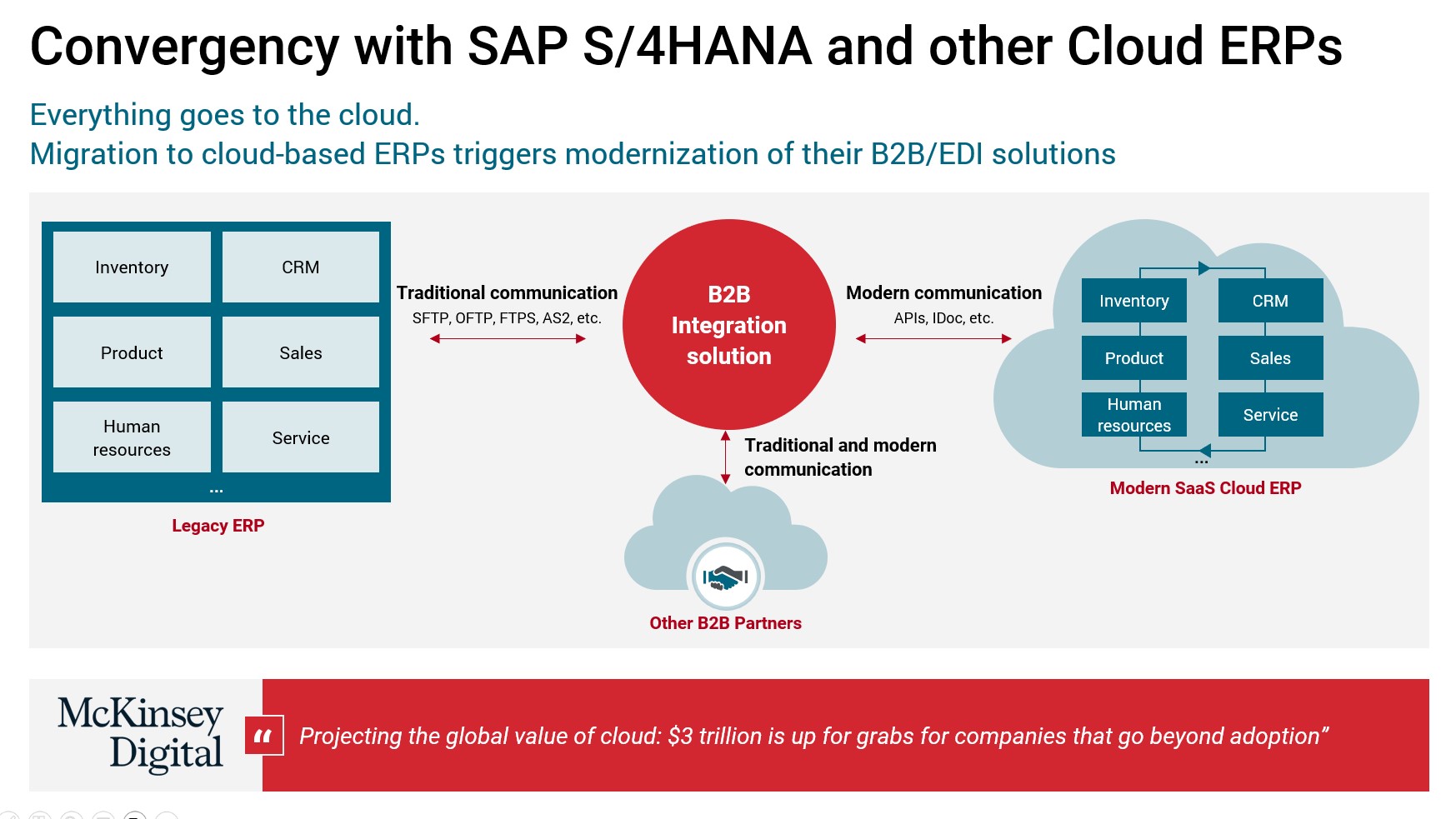In today’s hyper-connected world, millions of businesses are in communication with one another on a daily basis and with a network of external partners that continues to grow. This growing B2B integration opens up new opportunities, but it also leaves businesses in a spot where they’re dealing with daily challenges and have to find the right way to pivot — fast.
What’s more, this is not the end: AI, robotics, and improved connectivity are already changing the future of B2B.
Before offering up a unique solution that addresses this exact problem — the Axway B2B Integration Platform — let’s take a closer look at the current battles businesses face in B2B integration modernization.
Top challenges in navigating modern B2B integration
1. Accounting for new digital use cases
While EDI continues to drive many business processes, the API market is experiencing significant growth too. The automotive standards body Odette, for instance, suggests using standardized REST API interfaces for an adjacent visibility layer. These interfaces improve collaboration in logistics management, e-business communications, and engineering data exchange.
Another player in the industry, the Catena-X consortium aims to power the digital flow of information across the entire supply chain through standardized data exchange and cross-company applications. to power the digital flow of information across the entire supply chain through standardized data exchange and cross-company applications.

This trend means that businesses looking to incorporate any future EDI/integration technology must be able to bridge between the classic EDI world and new API-driven processes.
Read more: Can EDI co-exist with newer integration patterns?
2. Complying with emerging regulations
Every day, there are more market regulations coming into the picture. One example is Import Control System 2 (ICS2).
With the number of goods imported into Europe to the tune of trillions of Euros, the EU has issued ICS2, an AS4-driven customs control effort that mandates all safety and security data are collected for goods entering the EU before they arrive.
The EU already mandates declarations through its new advance cargo information system for air shipments. Road, maritime, and rail shipments will need to be ICS2-compliant come March 2024.

Healthcare organizations work in an especially tightly regulated industry. In the United States, non-compliance with the Drug Enforcement Administration’s controlled substance regulations can cause major fines or even shutdowns for drug manufacturers, distributors, and pharmacies.
Axway’s CSOS solution is a good example of blending existing processes with API technology; it offers a modern API-enabled approach to achieving DEA regulatory compliance in a more cost-effective, agile, and secure way.
Another regulation affecting many of these same actors is the Drug Supply Chain Security Act (DSCSA). The final DSCSA implementation phase will take effect on November 27, 2023, mandating full traceability throughout the entire pharmaceutical supply chain.
Finally, e-invoicing is an area where evolving standards leave many companies scrambling to stay in compliance. To name only a few country mandates:
- France’s upcoming e-invoicing mandate for its VAT tax
- European e-invoicing requirements that affect countries well beyond the EU
- the Digital Business Network Alliance (DBNA) working on an e-invoice exchange framework in the United States.
Learn how expert guides can help you be ready for the future of e-invoicing.
3. Maintaining supply chain resilience
Supply chain disruptions are one of the main reasons for business losses. A recent report by the Capgemini Research Institute found that 89% of organizations see supply chain disruption as the top risk to business growth, ahead of the rising prices of raw materials and the energy crisis.

With supply chain resilience being a key priority, the report notes 43% of businesses plan to increase investment there.

The uncertainty that has coincided with recent social and geopolitical shifts has made it abundantly clear that businesses need to be able to respond to these variables.
4. Software that’s outdated for the times
Many traditional electronic data interchange (EDI) systems have started to show their age. As digital use cases evolve, legacy EDI software can make it difficult for IT teams to integrate EDIs and APIs, taking up their valuable time and creating a complex B2B network in the process.
At the same time, older software can lack the scalability that’s needed to keep up with the growing number of digital transactions without losing the speed at which they’re sent.

Adding even more complexity, B2B vendors can also announce end of life for solutions enterprises had been relying on, disrupting their status quo.
Many businesses must navigate between EDI, VAN, and API technologies, while still needing to stay connected with supply chain partners and other stakeholders in their ecosystems who may have varying connection capabilities.
5. Dealing with a lack of expertise
In a recent survey, 95% of employers reported encountering a skills shortage in their search for tech talent.
On one hand, the talent shortage is a product of skilled workers leaving the job market (whether you call it the Great Resignation, the Great Retirement, or the Great Rethink).
On the other hand, new skills, tools, and expertise are needed to modernize an organization’s B2B integration system.
6. Converging with the cloud
There’s a universal movement of business operations to the cloud. McKinsey analysts estimate that cloud adoption among Forbes Global 2000 companies could generate some $3 trillion in value by 2030.
Convergency with SAP S/4HANA and other Cloud ERPs is driving everything into the cloud. Migration to cloud-based ERPs triggered modernization of businesses’ B2B/EDI solutions, since those systems are tightly integrated.

While vital to B2B integration modernization, the migration process never happens in a single day. It can be weeks or months before data and workflows are migrated to the cloud.
Businesses still need to carry on and make money in that timeframe, which is why it’s important that your B2B integration software provider be able to bridge heritage infrastructure with the new, as well as being fully compatible with modern cloud ecosystems like SAP S/4HANA.
Powerful B2B Integration Capabilities with Axway
Axway B2B Integration Platform is built for the future. Our platform combines point-to-point EDI, an EDI supplier portal, VAN, API, and other business networks within your digital ecosystem into one secure environment that can easily adapt to demands.
If a supplier lacks EDI solutions, buyers can make it easy for them to connect to key processes through a web-based EDI supplier portal. And if other partners and customers require EDI, VAN, or API connectivity, with Axway you have the platform in place to accommodate them.
You gain maximum flexibility for digital communication and real-time interaction with every part of your business ecosystem.
Real-world uses of Axway B2B Integration Platform
The best way to illustrate the power of the B2B integration platform is through real-world examples.
For one leading European airline, the tipping point was the need to comply with ISC2. This mandate around the pre-registration of goods entering the EU requires the use of AS4 as a B2B protocol to deliver messages to EU customs — a protocol that the airline’s old system did not support.
AS4 is a fairly complex protocol and requires strong, sophisticated support. Axway B2B Integration Platform was an ideal choice because the solution is flexible enough to accommodate AS4 and other protocols partners demand, while delivering the speed to improve business workflows.
Discover more companies succeeding with Axway B2B Integration in the cloud.
In another scenario, a large retailer needed to move its core operations to the cloud in an effort to reduce the total cost of ownership and fill staffing gaps. However, its B2B infrastructure was not cloud-ready, scalable, or resilient.
With the help of Axway B2B integration experts, the customer was able to deploy securely and efficiently to the cloud, reducing business and technical risks in their quest to future-proof their B2B integration in the cloud.
Don’t wait to modernize your B2B infrastructure. With growing regulatory pressures, cloud migrations, and a greater-than-ever need for resiliency in your supply chain, today’s organizations need a B2B integration platform that can support a complete partner network.


